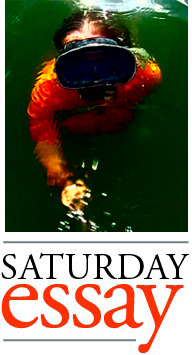Freediving the Edmund Fitzgerald
 It would be possible to dive to the wreck of the Edmund Fitzgerald on the strength of a single breath. Even at the wreck’s depth of 530 feet, it might actually be safer to dive unsupported by scuba tanks than to scuba dive to it. This essay is intended to hypothetically explore the intersection of different types of diving, the wreck itself, and the lake in general. At a minimum, I am suggesting that the freediving possibilities of Lake Superior have not been fully explored.
It would be possible to dive to the wreck of the Edmund Fitzgerald on the strength of a single breath. Even at the wreck’s depth of 530 feet, it might actually be safer to dive unsupported by scuba tanks than to scuba dive to it. This essay is intended to hypothetically explore the intersection of different types of diving, the wreck itself, and the lake in general. At a minimum, I am suggesting that the freediving possibilities of Lake Superior have not been fully explored.
My interest is provoked because I utilize some freediving breath-hold techniques in my underwater videography as Lake Superior Aquaman. I have never scuba dived, and so I think of the lake in freediving terms. I do not intend to offend the families of the deceased by invoking the Fitzgerald tragedy. However, its iconic stature as a deep wreck in Lake Superior makes it ideal for these illustrative purposes.
I am not suggesting any actual dives to the Fitzgerald. For one thing, both freediving and scuba diving present significant risks, especially beyond 100 feet deep. Also, it has been illegal to dive to the wreck since 2006, unless approved by the Canadian government in whose waters it lies. This is because of successful lobbying by the victims’ families to keep the wreck sacrosanct.
Comparing the risks of deep-water scuba diving with the risks of deep-water freediving will illuminate my assertion that freediving the wreck would not only be possible, but might actually be safer than using scuba. I will shed light on the depths involved and the nature of the challenge.
Any sort of dive to the Fitzgerald would require measures like: accompanying safety divers, underwater lighting systems, and sonar tracking of dive progress. My reasons for saying a freedive might be safer include less equipment that can go wrong, less exposure to the bends, less exposure to nitrogen narcosis, and less time spent underwater. I will detail these issues below.
Considering the depths involved, it is interesting to note that while 530 feet deep is extreme, the length of the Fitzgerald (before it broke apart) was 729 feet long. In other words, if you could stand an intact Fitzgerald on its end at the site where it sunk, nearly 200 feet of the ship would stick out of the water. Visualize this next time you see an ore boat on Lake Superior, the longest of which are the same general size. The wreck of the Fitzgerald lies at a depth approximately 3/4 the length of these freighters.
For the sake of a comparative visualization, the Titanic was 883 feet long, and lies in 12,500 feet of water. You could stand 14 Titanics end-to-end and they still wouldn’t quite reach out of the ocean. Only the most advanced submarines can reach that wreck. The Fitzgerald is reachable by human hands.
Scuba Diving
The Fitzgerald lies beyond the reach of so-called recreational scuba diving. Past 100 feet deep, the term “technical diving” comes into use, as more specialized skills and equipment are involved to address the skyrocketing risks.
Scuba tanks, which allow scuba divers to breathe underwater for a long time, contain a mix of gasses including helium and nitrogen. Breathing these gasses brings them into the bloodstream, and it is their expansion in the blood which causes the well-known danger of the bends. Also known as decompression sickness, this occurs when ascending from deep-water pressures to the lighter pressures closer to the surface. The gasses, compressed in the blood at depth, expand as the diver ascends. This is a serious health risk which, unmitigated, includes paralysis and death. Scuba divers avoid the bends by ascending slowly, and stopping in stages for many minutes at a time. This allows the pressures of these expanding gasses to lessen. If the proper protocols are followed, decompression sickness is avoided. The trade-off is that scuba divers on deep dives must spend most of their dive time ascending, waiting for prescribed times at various depths.
For example, the world record scuba dive is held by Ahmed Gabr, who dove 1,090 feet in the Red Sea. This is deeper than orca whales and dolphins are known to dive. It took him 12 minutes to descend that far. And to avoid the bends, he took 15 hours to reach the surface. (“Ahmed Gabr breaks record for deepest SCUBA dive at more than 1,000 feet,” by Mike Janela, Guinness World Records news, Sept. 22, 2014. See also: “What are the deepest dives and world record of depth?,” Scotty’s Action Sports Network) Gabr’s dive had taken him to more than double the depth of the Fitzgerald, but not quite as deep as Lake Superior’s deepest point of 1,332 feet.
Another risk associated with deep scuba dives is nitrogen narcosis. This is also known as “the martini effect.” Each 33 feet of depth doubles the water pressure, which drives more nitrogen into the brain, fogging it. This produces the mind-bending equivalent of drinking one martini every 33 feet down. Specialized air mixes are required to ameliorate the risk.
The book Shipwrecks of Lake Superior, edited by James R. Marshall (Lake Superior Port Cities Inc., 1987), contains Marshall’s chapter “The Deep Dive.” There he records the terrifying and potentially deadly effects of nitrogen narcosis that affected a scuba team in 1980 while diving the wreck of the Gunilda. At 245 feet deep, the Gunilda lies at less than half the depth of the Fitzgerald. The divers consisted of Joe Schneeweis, Gerald Buchanan, and Bob Horton. Marshall writes, “Word that in 1975 a diver, King Hague, from Thunder Bay had been lost while diving on the Gunilda displaced the formerly light banter which was driving them toward the inevitable attempt to reach the fabled wreck … It was at the bottom … that Gerry’s world began to revolve, or ‘spiral’ in divers’ jargon. Advanced narcosis had taken control, and he felt the very real presence of King Hague grasping and pulling on him, urging him to join the endless sleep of the depths. ‘It was so real,’ Gerry remembers, ‘I KNEW he was there. I could feel him pulling on my weight belt. My little world spun around me, faster and faster.’ Gerry doesn’t remember anything more about that dive, except Joe holding him at the 50-foot decompression stop and his mind clearing.”
Nitrogen narcosis affected all three men on a subsequent Gunilda dive, nearly causing disaster. Gerry and Joe each suffered fogged minds when they realized Bob had succumbed to an even greater level of this “rapture of the deep.” They had to rescue him while suffering the effects themselves.
The only scuba dive to the Edmund Fitzgerald (which required very technical skills, equipment, and air mixes) took almost four hours. It was accomplished by Terrence Tysall and Mike Zee. According to the Orlando Sentinel (“Orlando, Chicago divers first to touch the wreck of the Edmund Fitzgerald,” by Jerry Fallstrom, Sept. 10, 1995), and MyNorth (“Death-defying dive the Edmund Fitzgerald in 1995,” by Gerald Volgenau, Nov. 10, 2008), it took six minutes to descend to the wreck, six minutes to explore and video the site, and three hours and fifteen minutes to ascend. The men did not suffer from the bends, nor from nitrogen narcosis, but the dive was complicated by their suits’ regulators freezing up in the frigid waters. The dive has been likened to climbing Mount Everest. They survived by having multiple redundant back-up systems, a great deal of skill, and luck.
Freediving
Freediving is diving unsupported by air tanks. The freediver takes a single breath and slips beneath the waves. I am merely an amateur enthusiast, and I do not claim any special skill in the freediving disciplines, of which there are many. Examples include static apnea (breath holding at the surface), constant weight no fins (diving unaided by flippers), and no-limits apnea (deeper diving using weighted sleds along a dive line).
I have never dived beyond a thirty-foot depth. That may sound deep to the uninitiated — it sounded deep to me! — but in the world of competitive freediving it is a laughably shallow figure. I was underwater for less than a minute. I had seen a depth chart of Duluth’s outer harbor, and it cited the red obstruction buoy (within view of the Lakewalk, mostly in warmer months) as marking that depth. I videoed myself doing it, and you can tell I am a little nervous as the video begins.
It seemed daunting, and I did not wish to dally down there. I was less worried about my ability to reach 30 feet than I was about being startled by fish gliding out of the gloom. It was a confidence-building exercise as much as it was a publicity stunt. But my skills are obviously pedestrian. World champion freedivers have reached in excess of 800-foot depths. It is considered possible to someday reach 1000 feet. The Fitzgerald is easily within the range that competitive, no-limits freedivers regularly descended to until recently – I am informed that competitions now have limits of 400 feet for safety reasons. People just ,,, kept going deeper, risking their lives.
The deepest freedivers hold onto a sinking “sled” until it reaches the desired depth. Surfacing is often accomplished by inflating a balloon with a gas canister, which carries one back to the surface. Both the sled and the balloon contraption must be in perfect working order for a successful dive. Notably, Audrey Mestre died in the Caribbean in 2002 when, at a then-record depth of 561 feet, her balloon failed to inflate. She was more than 30 feet deeper than the Fitzgerald.
In 2007, the world record in no-limits was set at 702 feet deep by Herbert Nitsch. That is 172 feet deeper than the Fitzgerald. Descending on a sled and then ascending with the balloon, the entire dive took four minutes and 24 seconds (“5 Longest Free Dives of All Time,” Seeker, Nov. 8, 2011).
But Nitsch’s maximum breath hold is in excess of nine minutes. Consider that it would have taken even less than four minutes and 24 seconds to descend to the Fitzgerald’s depth of 530 feet and ascend again. With the time remaining in his maximum breath hold, Nitsch could have spent almost as much time at the wreck as the six minutes spent by the scuba divers Terrence Tysall and Mike Zee. And he would have been back at the surface within minutes, as opposed to the more than three hours it took Tysall and Zee to ascend.
That is because freedivers are not subject to the bends as much as scuba divers are. The gas mixes breathed by scuba divers are not used in freediving. Nitrogen is naturally present in the air, but freedivers only have one breath’s worth in their bloodstream, and so the expansion effects are less than in scuba, where nitrogen is constantly breathed. Therefore, the potentially crippling or fatal effects of gasses expanding in the blood are not as much in play in freediving as a rule. So, the freediver does not have to pause in general during ascent.
Except on particularly deep dives. Nitsch is an example of the health risks. He suffered decompression effects during a record-attempt dive to 818 feet. His injuries — a suite of mini-strokes — still affect his balance and coordination (“‘I Knew I Shouldn’t Have Done It,’ Says Free Diver Herbert Nitsch, Who Nearly Died Trying to Break His Own Record,” CBS News, March 5, 2013. See also: “Herbert Nitsch Talks About His Fateful Dive and Recovery,” Deeper Blue, June 6, 2013).
In addition to the bends, the causes of decompression sickness can include ascent-induced hypoxia (insufficient oxygen). In the deep, one may have enough oxygen in the blood to sustain consciousness, but as water pressure decreases upon ascent, that same level of oxygen becomes insufficient. Speaking generally, water pressure compacts the oxygen in the blood. This causes even a small amount of oxygen to be enough to sustain consciousness. On ascending however, the lessening water pressure causes the oxygen in the blood to diffuse, and the freediver can lose consciousness. Freedivers who suffer this can seem fine until they have almost fully ascended. Then they pass out inches from the surface and must be rescued or they will drown.
The most haunting case I have read about is of Junko Kitahama (“Open Your Mouth and You’re Dead,” by James Nestor, Outside, Jan. 25, 2012). At a competition off the Grecian coast, in 2011, she passed out right below the surface on her way back from a 180-foot dive. As she was revived, she said, “I was swimming and then I just started dreaming.”
This is more or less what happened to Herbert Nitsch on his freedive to 818 feet. He passed out 328 feet beneath the surface on an automatic sled that carried him up past the point he was to have a one-minute decompression. In terms of our thought experiment of freediving the Fitzgerald, Nitsch’s near-fatal dive was 300 feet deeper than the Fitzgerald lies.
My personal best breath hold record stands at four minutes, which I am very proud of. But professional freedivers can almost triple that. The current world record stands at 11 minutes and 54 seconds by Branko Petrovic. This limit can be exceeded even further by breathing pure oxygen for 30 minutes beforehand. The world record in a pure-oxygen breath hold stands at a staggering 24 minutes and 11 seconds by Budimir Sobat.
Nitrogen narcosis is also at play in freediving. In Outside magazine’s 2011 article cited above, it paraphrases William Trubridge saying: “(A)t 150 feet, you enter a dream state caused by the high levels of carbon dioxide and nitrogen gas in your bloodstream: for a moment, you can forget where you are and why.”
Water pressure also forces physiological changes. The lungs compact to the size of fists at around 300 feet down, and blood vessels swell to avoid being crushed. Fine motor control is affected as blood redirects from the limbs to the organs. Some of the changes seem designed by evolution to aid the dive. The so-called mammalian dive reflex causes the heart to beat slower, which conserves oxygen. The spleen, squeezed by water pressure, releases more oxygen-rich blood. At depth, the physiology of the freediver functions much like a dolphin.
The Cold etc.
The other complicating factor of freediving Lake Superior, especially deep diving, is the cold. On average, the lake presents Farenheit temperatures in the 30s, which must be met with thick wetsuits, drysuits, and other equipment. There also exist meditative and breathing techniques (such as Wim Hoff practices) which confer greater cold resistance. Freedivers are currently diving frigid seas, including under frozen ice sheets, and between icebergs. Diver Kiki Bosch is an example of a seeming immunity to the cold, diving arctic waters in only a swimsuit. In theory, there is no reason why the glacial depths of Lake Superior should be categorically beyond the reach of well-prepared and well-trained freedivers.
As well the buoyancy of salt water vs. fresh water is different. All this would have to be carefully considered.
Freediving the Edmund Fitzgerald would be at the limits of human endurance, but when has that ever stopped anyone?
The Sanctity of the Wreck
The debate about the propriety of diving the Fitzgerald is neatly summarized in the article “Worries About Intruders at Wreck of the Edmund Fitzgerald” (Nov. 5, 2000, The New York Times). The concerns of surviving family members finally broke through to the Canadian government. Many families do not consider their loved ones fully “at rest” as long as improvements to dive technology make more dives more likely.
A counterpoint is offered by diver David Trotter, who noted, “We don’t allow people to desecrate cemeteries, but we don’t prevent people from visiting cemeteries … the fact that there are remains on Everest does not prevent people from making the individual choice to explore it.” Those are the terms of the debate and the tension lies along that moral axis.
In 1994, a submarine expedition organized by diver Fred Shannon visited the wreck, discovering and taking images of a corpse at the site. Publication distressed the grieving families, who finally succeeded in restricting dive access, except for government-sponsored scientific research (“Book Photo, Video of Crewman’s Remains Angers Victims’ Families,” by John Flesher, Associated Press, Nov. 3, 1995).
Shannon argued that since the images do not identify the body, he was acting respectfully while documenting the facts. The images may in fact help solve the mystery of the sinking. The body is wearing a life jacket, which might indicate the ship did not sink as suddenly as the official theory maintains.
The video and photographs did not strike all family members as inherently disrespectful. As the AP reported, “Jack Champeau, whose brother, Oliver ‘Buck’ Champeau died in the shipwreck, said he did not object to Shannon’s use of the pictures as long as the body cannot be identified. ‘The remains should be treated reverently and with respect, but the fact is the men have died; they’re no longer there.’”
Others disagreed with him pretty strongly, like Cheryl Rozman whose father perished in the catastrophe. She said, “I can’t believe (Shannon)’s doing this to us. That is my dad’s grave and it should be respected.” It was Rozman who led the eventually successful push to ban diving there and the recording of images of shipwreck victims.
Postscript: Tempted by Other Wrecks
I have researched wrecks closer to Duluth in shallower water that I might be able to dive to. Since I have only ever been to 30 feet, that is the depth I have held as my general limit. Wrecks within that depth lie at Two Harbors, and a couple around the Apostle Islands, and the Alger Underwater Diving Preserve at Munising, Michigan. But the one that tempts me the most I have basically decided not to try. That is the wreck of the Thomas Wilson, a 308-foot whaleback steamer, much like the SS Meteor on display at Barker’s Island in Superior. The Wilson got T-boned by the George Hadley in 1902, and sank within three minutes. Nine crewmen lost their lives.
The wreck tempts me because it is only within a mile of the Duluth Ship Canal and no one has freedived it before, so I could put another notch on my trident. Draw a line from North Eighth Avenue East that intersects with a line from the canal, and that is the wreck’s approximate location. Ships at anchor there are hovering over it. You could reach the site in a kayak. The Wilson lies in 70 feet of water, but the wreck itself is 15-20 feet high. I always figured I could probably freedive over the top of it at a doable 50-foot depth. Sounds easy, right?
But I read somewhere once that since the Wilson is directly in the shipping lanes, the water is normally murky from being churned up. Also, over time, other ships have dragged their anchors through the wreck, so its hull is torn wide open. It is apparently possible for scuba divers to find themselves inside the wreck unawares, a dangerous situation in low visibility. Recreational shipwreck diving is one thing, but going into shipwrecks is considered technical diving, a whole other skill set.
Finally, I found a first-person account in the book Shipwrecks of Lake Superior on p. 76 that put me off the idea for good. It is by scuba diver Paul von Goertz, and I will end it here as a cautionary tale lest anyone think this essay has been too flippant about the dangers of diving the lake: “I cannot let anyone reading about my diving experiences on the Wilson believe such diving can be attempted by an inexperienced diver. It is a very dangerous dive because of the poor visibility, currents, danger of entanglement in debris and passing vessel traffic. On my last dive on the Wilson in 1974, I became lost in the cold darkness while inside the vessel. I fought the urge to panic three, four, five times and finally fought my way out. I surfaced in the bright warm sunshine covered with rust, and with less than 30 pounds of air pressure in an air tank which when full contained more than 2,000 pounds. I made one more wreck dive after this incident, but the fear I had experienced with the last Wilson dive still haunted me. A month later I sold all of my scuba gear. I have not dived since.”
It should be noted that von Goertz also states, “A safe guess would be that the men entombed in the wreck might be found in the boiler room, as this was the compartment nearest the actual point of collision.”
-All my essays here.
Recommended Links:
Leave a Comment
Only registered members can post a comment , Login / Register Here













No Comments